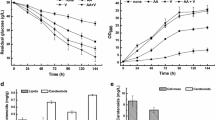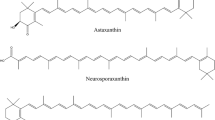Abstract
This report presents results in the composition of major carotenoids of various coloured mutants of the genusRhodotorula and of mating types of the genusRhodosporidium.
The separation of carotenoid intermediates was carried out by thin layer chromatography using Silufol 254 Kavalier and the determination of eluated spots by spectrophotometry.
There was found no difference in carotenoid composition of both mating typesa and α of individual species of the genusRhodosporidium. The vegetative and sexual reproduction ofRhodotorula andRhodosporidium can be separated from the carotenogenesis using 10−4 mol diphenylamine.
It was concluded that lycopene could be the intermediate to mono- and dicyclic carotenoids; in the case of partial inhibition of the dehydrogenation step the direct cyclization of neurosporene to β-zeacarotene can be expected.
An unknown compound, probably lycopersene was found and was considered to be the precursor of phytoene. Phytoene and phytofluene were proved in all studied samples.
Nutritional conditions (vitamins, sulfur amino acids, etc.) are able to shift the ratios between major carotenoids.
Rhodotorula aurantiaca strains were observed to be auxotrophic mutants of various characters and the existence of this species as independent one, was denied.
Zusammenfassung
In diesem Bericht wurden die Ergebnisse zusammengebracht, die über die Zusammensetzung hauptsächtlicher Carotinoide der pigmentlosen Mutanten der GattungRhodotorula and der Paarungstypen der GattungRhodosporidium berichten.
Die Trennung der Zwischenprodukte der Carotinoidsynthese folgte bei Dünnschicht-chromatographie an Silufol 254 Kavalier und die Bestimmung einzelner Substanzen bei der Spektrophotometrie.
Es wurden keine Differenzen in der Zusammensetzung der Carotinoide beider Paarungstypen desRhodosporidiums gefunden. Die vegetative und sexuelle Vermehrung der GattungenRhodotorula undRhodosporidium können von der Carotinoidsynthese mit Hilfe des 10−4 mol Diphenylamins getrennt werden.
Aus den obengegebenen Ergebnissen folgt, dass Lycopin als Intermediat zu mono- und dicyklischen Carotinoide führt. Ist die Stufe der Dehydrogenation teilweise inhibiert, so kann Neurosporin direkt cyklisiert werden und zur Produktion des β-Zeacarotins führen.
Es wurde weiter eine nicht bestimmte farblose Substanz entdeckt, die als Prekursor des Phytoens betrachtet werden konnte. Phytoen und Phytofluen wurden in allen Proben gefunden.
Die Nahrungsbedingungen (Vitamin-, Aminosäuren- u.a. Zusammensetzung) können über die beiderseitigen Verhältnisse zwischen einzelnen Carotinoidzwischenprodukten entscheiden, was durch Verfütterungsversuche nachgewiesen wurde.
Rhodotorula aurantiaca Stämme wurden als polyauxotrophe Mutanten gefunden so, dass über die Existenz einer selbständigen ArtRhodotorula aurantiaca gezweifelt wurde.
Similar content being viewed by others
References
Banno, J. (1967) Studies on the sexuality of Rhodotorula. J. gen. Microbiol. 13: 167–197.
Bartels, P. G. & C. McCullough (1972) A new inhibitor of carotenoid synthesis in higher plants: 4-chloro-5(dimethylamino)-2-α,α,α (trifluoro-m-tolyl)-3(2H)-pyridazinone. Biochem. Biophys. Res. Comm. 48: 16–22.
Binhl, E., W. Lang & W. Rau (1970) Untersuchungen an die lichtabhängige Carotinoidsynthese. VI. Zeitlicher Verlauf der Synthese der einzelnen Carotinoide bei Fusarium aqueductum unter verschiedenen Induktionsbedingungen. Planta (Berl) 94: 156–174.
Cohen, C. N. (1967) Biosynthesis of small molecules. Modern perspectives in biology. Hayser and Row, New York.
Davies, B. H. (1969) Structural studies on bacterial carotenoids and their biosynthetic implication. Pure appl. Chem. 20: 545–555.
Fiasson, J. L. & N. Arpin (1967) Recherches chimicotaxonomiques sur les champignons. V. Sur les carotenoides meneurs de Cantharellus tubaeformis Fr. Bull. Soc. Chim. Biol. 49: 537–542.
Fiasson, J. L., P. Lebreton & N. Arpin (1968) Les carotenoïdes des champignons. Bull. Soc. naturalistes et archéologues 82: 47–67
Goodwin, T. W. (1971) Biosynthesis of carotenoids and plant triterpenes. Biochem. J. 123: 293–329.
Guber, S., A. W. T. Konings & R. J. Guillory (1972) The effect of aging resolved chromatophores of Rhodospirillum rubrum on the capacity to reconstitute the energy-linked transhydrogenation. Biochim. Biophys. Acta 255: 167–170.
Herber, R., B. Maudinas &J. Villoutreix (1972) Mise en évidence d'isomeres de phytoene et de phytofluene chez Rhodopseudomonas spheroides, Rhodospirillum rubrum et Mucor hiemalis. C.R. Acad. Sci. Paris 274: 327–329.
Karrer, P. & E. Jucker (1948) Carotinoide. Birkhäuser, Basel.
Killick, K. A. (1972) Modification of pigmentation and cell-wall structure of Rhodotorula aurantiaca by culture in the presence of sulfur amino acids. Canad. J. Microbiol. 18: 423–427.
Kocková-Kratochvílová, A. & A. K. Wegener (1973) Die Beziehungen innerhalb der Gattung Rhodotorula Harrison. Zentbl. Bakt. Parasitkde. (Abt. II) (in press).
Lang, W. & W. Rau (1972) Untersuchungen über die lichtabhängige Carotinoidsynthese. IX. Zum Induktionsmechanismus der carotinoidbildenden Enzyme bei Fusarium aqueductum. Planta (Berl.) 106: 345–354.
Liaaen-Jensen, S. (1970) Developments in the carotenoid field. Experientia 26: 697–710.
Liaaen-Jensen, S. & A. G. Andrews (1972) Microbial carotenoids. Ann. Rev. Mikrobiol. 26: 225–244.
Maudinas, B., R. Herber, J. Volloutreix & P. Granger (1972) Influence du 2-hydroxybiphenyle sur la carotenogense de Rhodopseudomonas spheroides et de Rhodospirillum rubrum. Biochemie 54: 1085–1088.
Moo Bae & C. O. Chichester (1972) Biosynthesis of carotenoids in asporogenous yeasts. Fourth Int. Symp. Ferment., Kyoto, Japan: G 15-5.
Peterson, W. J., E. Lecce, T. A. Ball & J. L. Etchels (1958) Quantitative determination of the carotenoids in yeasts of the genera Rhodotorula. J. Bacteriol. 75: 586–590.
Quereshi, A. A., F. J. Barnes & J. W. Porter (1972) Lycopersene and prelycopersene pyrophosphate. J. Biol. Chem. 247: 6730–6732.
Rabourn, W. J. & F. W. Quackenbush (1953) Occurrence of phytoene in various plant material. Arch. Biochem. Biophys. 44: 159–165.
Rabourn, W. J. & F. W. Quackenbush (1956) The structure of phytoene. Arch. Biochem. Biophys. 61: 111–116.
Rau, W. (1971) Untersuchungen über die lichtabhängige Carotinoidsynthese. VII. Reversible Unterbrechung der Reaktionskette durch Cycloheximid and anaerobe Bedingungen. Planta (Berl.) 101: 251–264.
Theimer, R. R. & W. Rau (1970) Untersuchungen über die lichtabhängige Carotinoidsynthese. V. Aufhebung der Lichtinduktion durch Reduktionsmittel und Ersatz des Lichts durch Wasserstoffperoxyd. Planta (Berl.) 92: 129–137.
Wallace, V. & J. W. Porter (1952) Phytofluene Arch. Biochem. 36: 468–472.
Zechmeister, Z. & A. Sandoval (1946) Phytofluene J. Amer. Chem. Soc. 68: 197–199.
Author information
Authors and Affiliations
Rights and permissions
About this article
Cite this article
Kocková-Kratochvílová, A., Bystrický, S. The problem of carotenoid biosynthesis in the taxonomy of genera Rhodotorula and Rhodosporidium. Mycopathologia et Mycologia Applicata 54, 409–419 (1974). https://doi.org/10.1007/BF02050047
Accepted:
Issue Date:
DOI: https://doi.org/10.1007/BF02050047




